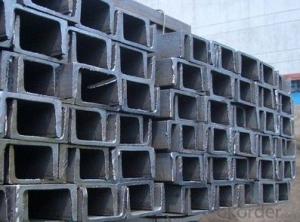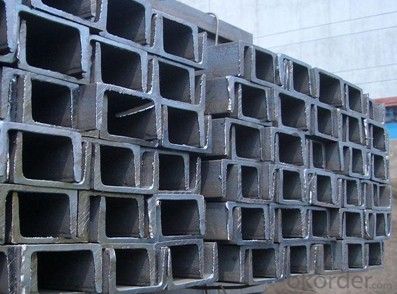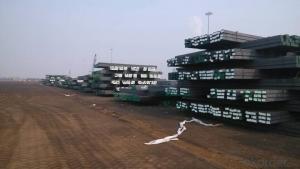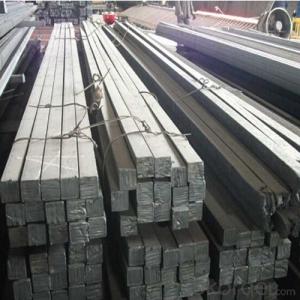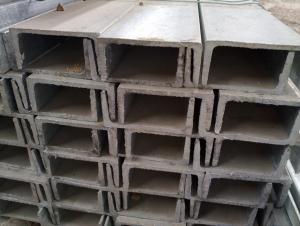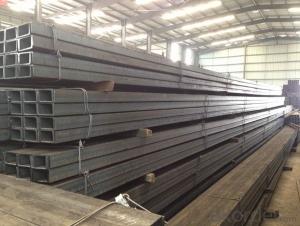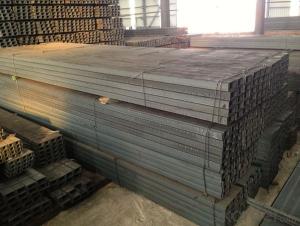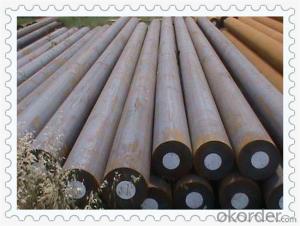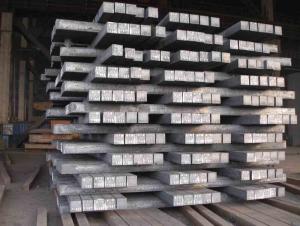Steel U Channel GB Q235 JIS G3192 Hot Rolled High Quality
- Loading Port:
- Tianjin
- Payment Terms:
- TT or LC
- Min Order Qty:
- 25 m.t.
- Supply Capability:
- 2000000 m.t./month
OKorder Service Pledge
OKorder Financial Service
You Might Also Like
Product Description:
OKorder is offering Steel U Channel GB Q235 JIS G3192 Hot Rolled High Quality at great prices with worldwide shipping. Our supplier is a world-class manufacturer of steel, with our products utilized the world over. OKorder annually supplies products to European, North American and Asian markets. We provide quotations within 24 hours of receiving an inquiry and guarantee competitive prices.
Product Applications:
According to the needs of different structures, Angle can compose to different force support component, and also can be the connections between components. It is widely used in various building structures and engineering structures such as roof beams, bridges, transmission towers, hoisting machinery and transport machinery, ships, industrial furnaces, reaction tower, container frame and warehouse etc
Product Advantages:
OKorder's Steel U Channel GB Q235 JIS G3192 Hot Rolled High Quality are durable, strong, and resist corrosion.
Main Product Features:
· Premium quality
· Prompt delivery & seaworthy packing (30 days after receiving deposit)
· Corrosion resistance
· Can be recycled and reused
· Mill test certification
· Professional Service
· Competitive pricing
Product Specifications:
Manufacture: Hot rolled
Grade: Q195 – 235
Certificates: ISO, SGS, BV, CIQ
Length: 6m – 12m, as per customer request
Packaging: Export packing, nude packing, bundled
Sizes: 25mm-250mm | ||||||||||||
a*t | ||||||||||||
25*2.5-4.0 | 70*6.0-9.0 | 130*9.0-15 | ||||||||||
30*2.5-6.6 | 75*6.0-9.0 | 140*10-14 | ||||||||||
36*3.0-5.0 | 80*5.0-10 | 150*10-20 | ||||||||||
38*2.3-6.0 | 90*7.0-10 | 160*10-16 | ||||||||||
40*3.0-5.0 | 100*6.0-12 | 175*12-15 | ||||||||||
45*4.0-6.0 | 110*8.0-10 | 180*12-18 | ||||||||||
50*4.0-6.0 | 120*6.0-15 | 200*14-25 | ||||||||||
60*4.0-8.0 | 125*8.0-14 | 250*25 | ||||||||||
FAQ:
Q1: Why buy Materials & Equipment from OKorder.com?
A1: All products offered byOKorder.com are carefully selected from China's most reliable manufacturing enterprises. Through its ISO certifications, OKorder.com adheres to the highest standards and a commitment to supply chain safety and customer satisfaction.
Q2: How do we guarantee the quality of our products?
A2: We have established an advanced quality management system which conducts strict quality tests at every step, from raw materials to the final product. At the same time, we provide extensive follow-up service assurances as required.
Q3: How soon can we receive the product after purchase?
A3: Within three days of placing an order, we will begin production. The specific shipping date is dependent upon international and government factors, but is typically 7 to 10 workdays.
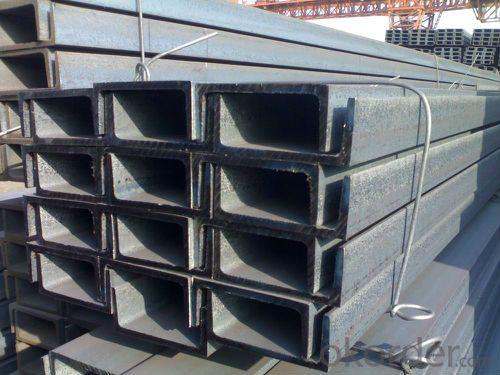

- Q: How do you use a steel square to measure the height of a countertop?
- To use a steel square to measure the height of a countertop, you would place one edge of the square against the underside of the countertop and extend it vertically until it reaches the desired height. Then, the measurement can be read from the markings on the square, providing an accurate measurement of the countertop's height.
- Q: Can a steel square be used for shed construction?
- Certainly! Shed construction can definitely benefit from the use of a steel square. Known as a framing square or carpenter's square, this versatile tool is commonly employed in carpentry and construction projects. Its construction from durable steel allows it to withstand heavy use. The steel square serves multiple purposes in construction. It facilitates the laying out and marking of angles, enables accurate measurements, ensures squareness, and guarantees straight lines and right angles. Its surface is marked with measurements and indicators, enabling precise and efficient calculations. In shed construction, the steel square finds various applications. It aids in marking and measuring lumber for precise cuts, ensuring proper fitment of all pieces. It also verifies squareness and straightness during assembly, guaranteeing accurate and even construction. Moreover, the steel square ensures the alignment and angle of shed components such as walls and roofs. This is particularly crucial for sheds with gable roofs, as the steel square assists in cutting and installing roof rafters at the correct angle to facilitate water runoff. In summary, the steel square is an invaluable tool for shed construction, offering assistance in achieving precise and accurate results.
- Q: Can a steel square be used for checking the squareness of a power planer table?
- It is not possible to use a steel square to check the squareness of a power planer table. Steel squares are commonly used to check the squareness of corners or edges of materials, but they are not suitable for larger surfaces like power planer tables. In order to accurately check the squareness of a power planer table, it is recommended to use specialized tools such as precision straight edges or dial indicators. These tools provide precise measurements and ensure that the table is perfectly square, which is crucial for achieving accurate and consistent planing results.
- Q: What is the purpose of the lip or flange on a steel square?
- The lip or flange on a steel square serves the purpose of providing a reference edge for marking lines or making precise measurements. Typically positioned perpendicular to the body of the square, it allows for alignment with the workpiece's edge. By sliding the lip along the material's edge, it ensures proper alignment of the square and enables accurate marking or measuring. This useful feature finds particular application in woodworking, metalworking, and other trades that require precision. Moreover, the lip or flange can also function as a stop or guide for repetitive cuts or layouts, further enhancing its usefulness. Overall, the steel square's lip or flange enhances precision and efficiency in various industries by improving the accuracy of different tasks.
- Q: Can a steel square be used for checking the levelness of countertops?
- Using a steel square to check the levelness of countertops is not possible. The primary purpose of a steel square is to measure angles and guarantee the precision of right angles. To assess the levelness of countertops, it is necessary to utilize a level tool. A level is an instrument equipped with a bubble vial filled with liquid, enabling the determination of whether a surface is perfectly horizontal or vertical. This is crucial for countertops as it ensures their levelness, providing a stable and uniform surface.
- Q: Can a steel square be used for checking the levelness of a table saw top?
- No, a steel square cannot be used for checking the levelness of a table saw top. While a steel square is a useful tool for measuring right angles and checking the squareness of a surface, it is not designed to determine the levelness of a table saw top. To check the levelness of a table saw top, a precision level or a straight edge should be used. These tools are specifically designed for this purpose and provide accurate readings to ensure the table saw top is perfectly level, which is crucial for achieving precise and accurate cuts.
- Q: How do you use a steel square to determine the slope of a wheelchair ramp?
- In order to determine the slope of a wheelchair ramp using a steel square, it is necessary to follow the following procedures: 1. Position the steel square on the ramp so that one leg is in contact with the ground and the other leg is resting against the surface of the ramp. It is important to ensure that the square is positioned horizontally. 2. Adjust the square's position until it is perfectly level. A small bubble level can be placed on top of the square to ensure that it is completely flat. 3. Once the square is leveled, observe the position of the bubble level. If the bubble is centered between the two lines, it indicates that the ramp is perfectly level. If the bubble leans towards one side, it signifies that the ramp is sloping in that direction. 4. To determine the slope of the ramp, measure the distance between the two legs of the steel square. This distance is referred to as the "rise". 5. Next, measure the length of the base of the steel square where it makes contact with the ramp. This measurement is known as the "run". 6. Divide the rise by the run to calculate the slope ratio. For example, if the rise is 4 inches and the run is 48 inches, the slope ratio would be 4/48 or 1/12. 7. Finally, to express the slope as a percentage, multiply the slope ratio by 100. In this case, the slope would be 1/12 x 100 = 8.33%. By utilizing a steel square and following these steps, it is possible to accurately determine the slope of a wheelchair ramp. This is crucial in ensuring the safety and accessibility of the ramp for wheelchair users.
- Q: What is the purpose of a steel square?
- The purpose of a steel square is to provide a versatile and accurate measuring tool for various carpentry and woodworking tasks. It helps in measuring and marking right angles, laying out angles, and determining lengths and widths of materials.
- Q: Can a steel square be used for furniture making?
- Yes, a steel square can be used for furniture making. It can be used as a reliable tool for measuring and marking precise angles, ensuring accurate cuts, and maintaining the squareness and alignment of joints.
- Q: Can a steel square be used for measuring board thickness?
- No, a steel square cannot be used for measuring board thickness. Steel squares are primarily used for measuring and marking angles, not for measuring thickness. To measure board thickness accurately, you would need a tool specifically designed for that purpose, such as a caliper or a thickness gauge. These tools provide precise measurements in millimeters or inches, ensuring accuracy in determining the thickness of the board.
Send your message to us
Steel U Channel GB Q235 JIS G3192 Hot Rolled High Quality
- Loading Port:
- Tianjin
- Payment Terms:
- TT or LC
- Min Order Qty:
- 25 m.t.
- Supply Capability:
- 2000000 m.t./month
OKorder Service Pledge
OKorder Financial Service
Similar products
Hot products
Hot Searches
Related keywords
